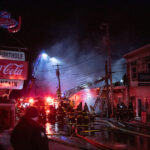“Is the world becoming a riskier place?”
That was the question posed by Insurance Information Institute President and Chief Economist Robert Hartwig during his talk at the annual Professional Liability Underwriting Society Conference in San Diego on Wednesday, which drew over 1,700 industry professionals this year.
Hartwig gave a resounding answer to the question, while admitting many risks and downsides to the insurance industry continue to exist.
“The world is nowhere near as risky as it has been,” he said.
In his speech Hartwig did his best to allay fears that 2011 is turning out to be another 2008. Though he acknowledged it’s tough to argue for, considering a host of disasters that have profoundly impacted the catastrophe market the year, including earthquakes, tsunamis, debt fears, the Eurozone economic crisis, the U.S. dollar, housing, stubbornly high unemployment and a government in Washington, D.C. that “is rudderless,” he said.
And then there’s the latest issue. The trouble with Greece’s economy. “We have the big, fat Greek debt problem,” he said.
But he called that problem “overblown,” considering that country’s economy is the 32nd largest in the world. By comparison, if California were a nation, its economy would rank 8th in the world.
“Greece has the economy of somewhere like Alabama,” he said, adding, “I think the high degree of uncertainty coming out of Europe is overblown.”
Despite all of this “economic malaise,” the worldwide economic situation is “very different from three years ago,” he said.
To back his reasoning, he pointed to the lack of numerous major financial failures, like Lehman Brothers, AIG and Wachovia, credit markets that aren’t seizing and bank balance sheets that are in much stronger shape.
As for the property/casualty industry, he noted that profits for the first-half of the year were down 71.6 percent to $4.8 billion versus the first-half of 2010 due to high cat losses and as non-cat underwriting results deteriorated.
Look for industry-wide return on equity to continue to stabilize, he said, adding “the industry is headed toward a trough in ROE.” ROE has fallen steadily each year, and while there is some stabilization, based on past history, he said he doesn’t see it peaking until 2016 or 2017.
He also noted that combined ratios must be lower in today’s depressed investment environment to generate risk-appropriate ROEs. The ratio for the first-half of 2011 was 109.4, according to I.I.I., which compiles its data from A.M. Best and ISO data.
As for the cat market, he said, “2011 will rewrite catastrophe loss and insurance history.”
The lion’s share of cat losses in 2011 came from the Asia Pacific area, instead of Europe. The first half of the year recorded 355 events. In the U.S. there were $25 billion in insured losses reported, a 129 percent increase over the $11.8 billion amount through the first half of 2010, Hartwig said.
He noted that the majority of those losses were “from a large number of modest catastrophic events,” and not a few large ones.
But even with those large losses, and other factors in the industry that seem to hint at a possible return to a hard market, Hartwig said he doesn’t see the market turning anytime soon.
However, he did offer his thoughts on sectors he feels will grow in the next 10 years. They are:
Heathcare
Health science
Alternative energy
Agriculture
Natural resources
Environmental
Technology
Light manufacturing
Export oriented industries
Shipping
Topics Market
Was this article valuable?
Here are more articles you may enjoy.


 Louvre Tightens Security After $102M Jewel Heist, Installs Bars on Infamous Window
Louvre Tightens Security After $102M Jewel Heist, Installs Bars on Infamous Window  Fire Damages Portland, Maine’s Historic Waterfront
Fire Damages Portland, Maine’s Historic Waterfront  Howden US Tells Judge Brown & Brown Employees Fled Due to ‘Mistreatment’
Howden US Tells Judge Brown & Brown Employees Fled Due to ‘Mistreatment’  FBI Involved After Two Florida Injury Lawyers Go Missing From Fishing Trip
FBI Involved After Two Florida Injury Lawyers Go Missing From Fishing Trip 

